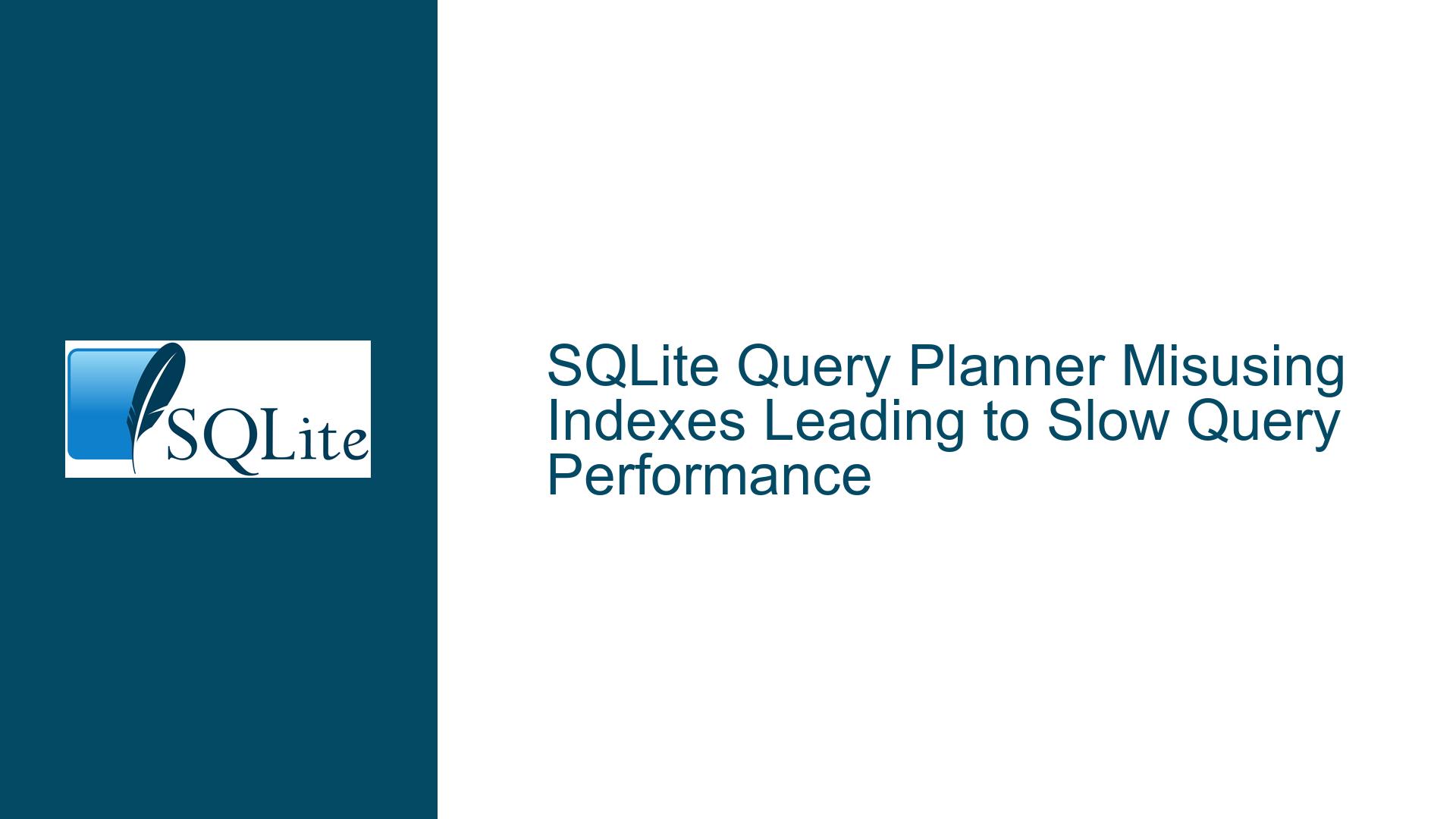SQLite Query Planner Misusing Indexes Leading to Slow Query Performance
Issue Overview: Misuse of Indexes by SQLite Query Planner
The core issue revolves around the SQLite query planner (QP) not utilizing the most efficient index for a given query, leading to suboptimal query performance. Specifically, the query planner is selecting an index (ix_tr_checkInYear) that is unrelated to the filtering condition in the WHERE clause (treatments.authorityName LIKE 'miller%'). Instead, it should be using the index on the authorityName column (ix_tr_authorityName), which is directly involved in the filtering condition. This misbehavior results in significantly slower query execution times, as the query planner is forced to scan a larger dataset than necessary.
The query in question involves a JOIN between two tables, treatments and materialsCitations, with a WHERE clause filtering on authorityName and a GROUP BY clause grouping by checkInYear. The query planner’s decision to use the ix_tr_checkInYear index instead of the ix_tr_authorityName index is counterintuitive, as the latter would allow for a more efficient search based on the authorityName condition. This issue is exacerbated when the GROUP BY clause is modified to use GROUP BY +checkInYear, which further confuses the query planner and introduces a BLOOM FILTER, adding additional overhead.
Possible Causes: Why the Query Planner Chooses the Wrong Index
The query planner’s decision-making process is influenced by several factors, including the presence of indexes, the distribution of data, and the structure of the query. In this case, the following factors contribute to the query planner’s suboptimal choice:
Index on
checkInYear: The presence of theix_tr_checkInYearindex seems to mislead the query planner. Even though this index is not directly used in theWHEREclause, its existence appears to influence the planner’s decision to prioritize it over theix_tr_authorityNameindex. This is particularly problematic because thecheckInYearcolumn is not involved in the filtering condition, making the index irrelevant for this query.Data Distribution and Statistics: The query planner relies on statistics collected by the
ANALYZEcommand to estimate the selectivity of indexes. If the statistics are outdated or inaccurate, the planner may make poor decisions. In this case, the planner may incorrectly estimate that theix_tr_checkInYearindex is more selective than theix_tr_authorityNameindex, leading it to choose the former.Query Structure and
GROUP BYClause: The structure of the query, particularly theGROUP BYclause, can influence the query planner’s choice of indexes. When theGROUP BYclause is modified to useGROUP BY +checkInYear, the planner is forced to disregard theix_tr_checkInYearindex, but this introduces aBLOOM FILTER, which adds additional overhead. This suggests that the query planner is struggling to balance the requirements of theGROUP BYclause with the filtering condition in theWHEREclause.BLOOM FILTER Optimization: The introduction of a
BLOOM FILTERin the query plan when usingGROUP BY +checkInYearindicates that the query planner is attempting to optimize the query by reducing the number of rows that need to be processed. However, this optimization is not effective in this case, as it still results in a slower query compared to manually specifying the correct index usingINDEXED BY.Virtual Column and Generated Indexes: The
checkInYearcolumn is a virtual column generated from thecheckinTimecolumn. While virtual columns can be useful, they can also complicate the query planner’s decision-making process, especially when indexes are involved. The query planner may not fully understand the relationship between the virtual column and the underlying data, leading to suboptimal index choices.
Troubleshooting Steps, Solutions & Fixes: Ensuring Optimal Query Performance
To address the issue of the query planner misusing indexes, several steps can be taken to ensure optimal query performance. These steps involve both modifying the query and the underlying schema to guide the query planner toward making better decisions.
Remove Unnecessary Indexes: One of the simplest solutions is to remove the
ix_tr_checkInYearindex, as it is not needed for this query. By removing this index, the query planner is forced to consider other indexes, such asix_tr_authorityName, which is directly relevant to the filtering condition in theWHEREclause. This can be done using the following command:DROP INDEX ix_tr_checkInYear;After removing the index, the query planner should no longer be misled by the presence of an irrelevant index, and the query performance should improve.
Use
INDEXED BYto Force Index Usage: If removing theix_tr_checkInYearindex is not an option, theINDEXED BYclause can be used to explicitly instruct the query planner to use theix_tr_authorityNameindex. This approach ensures that the query planner uses the correct index, even if it would not normally choose to do so. The modified query would look like this:SELECT checkInYear, Count(DISTINCT materialsCitations.materialsCitationId) AS num FROM treatments INDEXED BY ix_tr_authorityName JOIN materialsCitations ON materialsCitations.treatmentId = treatments.treatmentId WHERE treatments.authorityName LIKE 'miller%' GROUP BY checkInYear;This approach is particularly useful when the query planner consistently makes poor index choices, but it should be used with caution, as it can lead to maintenance challenges if the schema changes.
Modify the
GROUP BYClause: As suggested in the discussion, modifying theGROUP BYclause to useGROUP BY +checkInYearcan help the query planner disregard theix_tr_checkInYearindex. However, this approach introduces aBLOOM FILTER, which can add overhead. To mitigate this, theBLOOM FILTERoptimization can be disabled using the following command:.testctrl optimizations 0x80000Disabling the
BLOOM FILTERoptimization can improve query performance, but it should be done with caution, as it may affect other queries.Rewrite the Query to Use
BETWEENInstead ofLIKE: Another approach is to rewrite the query to use aBETWEENclause instead of aLIKEclause. This can help the query planner better understand the filtering condition and choose the correct index. The modified query would look like this:SELECT checkInYear, Count(DISTINCT materialsCitations.materialsCitationId) AS num FROM treatments JOIN materialsCitations ON materialsCitations.treatmentId = treatments.treatmentId WHERE treatments.authorityName COLLATE NOCASE BETWEEN 'miller' AND 'miller' || char(0x10ffff) GROUP BY checkInYear;This approach is particularly effective when the
LIKEclause is case-insensitive, as it allows the query planner to use theix_tr_authorityNameindex more effectively.Update Statistics with
ANALYZE: Ensuring that the statistics used by the query planner are up-to-date is crucial for optimal query performance. Running theANALYZEcommand can help the query planner make better decisions by providing it with accurate information about the distribution of data in the tables and indexes. This can be done using the following command:ANALYZE;After running
ANALYZE, the query planner should have a better understanding of the selectivity of the indexes and should be more likely to choose the correct index for the query.Consider Schema Design and Indexing Strategy: Finally, it is important to consider the overall schema design and indexing strategy. In some cases, the presence of certain indexes or the structure of the schema can lead to suboptimal query performance. For example, virtual columns like
checkInYearcan complicate the query planner’s decision-making process, especially when indexes are involved. In such cases, it may be necessary to reconsider the schema design or indexing strategy to ensure that the query planner can make optimal decisions.
By following these troubleshooting steps and solutions, it is possible to address the issue of the SQLite query planner misusing indexes and ensure optimal query performance. Each of these steps should be carefully evaluated in the context of the specific database and query requirements to determine the best approach.






